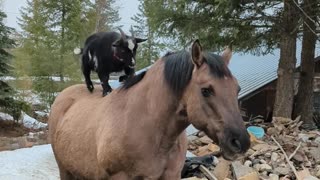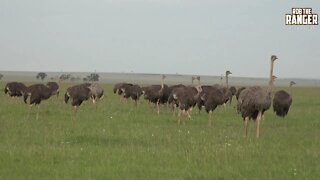The real story behind Morocco’s tree-climbing goats
http://corneey.com/ed3Yrb
Is it instinct or spectacle? Drought, desperation, and tourism combine to create a surprising tableau. ANIMALS
Some farmers in Morocco have been placing goats in trees for years to attract tourists.
PHOTOGRAPH BY ALFREDO CALIZ, PANOS PICTURES
BYERIKA HOBART
PUBLISHED JUNE 6, 2022
• 14 MIN READ
ESSAOUIRA, MOROCCOIt’s a challenging Friday morning for Jaouad Benaddi. He’s been trying to get his goats to climb an argan tree and settle in its gnarled, thorny branches. None of the 12 are cooperating.
Eager to help, Benaddi’s 13-year-old son Khalid grabs a bag of grain and hoists himself into the tree. One goat bleats and starts to follow. Khalid climbs higher on the widely spaced branches holding a bag of grain to encourage her to join him. He pauses long enough for the goat to catch up and eat for a moment, then grabs her neck to pull her toward him. She resists and jumps out of the tree.
Left: Khalid Benaddi, 13, uses a bag of grain to coax one of his family’s goats up an argan tree.
Right: Goats like to eat argan fruit, with its thick peel and sweet-smelling pulpy flesh.
PHOTOGRAPHS BY ERIKA HOBART
Boy and goat repeat the process three times, until Khalid gets her positioned on a small wooden platform, where she readjusts her footing and stops moving. It takes perseverance to get the rest of the goats to comply. Some must be maneuvered like cargo onto their platforms. Eventually, a dozen goats are standing eerily still, displayed like living ornaments in the argan’s canopy.
Morocco’s tree-climbing goats have made headlines in recent years. Often described as a natural phenomenon unique to the North African nation, their climbing is instinctual to an extent: The goats are attracted to the fruit in argans and, agile as they are, will clamber up to reach the pulpy treats.
Animal welsfare advocates and ecologists say that making goats stand in argan trees for hours is bad for the animals and bad for the trees.
PHOTOGRAPH BY WOLFGANG KAEHLER, LIGHTROCKET/GETTY IMAGES
Mauro Belloni, a student visiting from Italy who had stopped at Benaddi’s tree, looks both stunned and baffled as he takes in the scene. “It’s quite amazing,” he says. "I thought the goats were fake when I saw photos of them. But they're real—they’re actually posing.”
Morocco is experiencing its worst drought in decades, making it increasingly difficult for farmers to grow crops in this western region of Marakesh-Safi. Beginning in the early 2000s, some started treeing their goats to earn tips from tourists. The income source dwindled after the coronavirus pandemic hit in early 2020. But after the country’s lockdown ended early this year, the goat-display business resumed—and with it, criticism from animal welfare advocates such as Liz Cabrera Holtz, Wildlife Campaign Manager at World Animal Protection, a UK-based global nonprofit.
“These animals are being manipulated and exploited,” she says. “They're not moving freely. They don't have access to food, water, or even shade. Being forced to stay in trees for hours is not a normal behavior."
‘Flying goats’
The goats perched in Morocco’s trees are “trained to do it as a spectacle,” says Marrakech-based tour guide Mohamed Elaamrani. “They can climb trees and even mountains, and they’re really good at it. Some of my guests refer to them as flying goats. They want to see them because there’s nothing like this anywhere else in the world.”
AboutUs About us https://bit.ly/3GUPFOa
Contact us +919942258153 kvk.subadhra@gmail.com
Thank You Very Much for Sharing YourValuable Thoughts
https://a2425hsf13y7ot8704kfk7lwcp.hop.clickbank.net
-
 2:45
2:45
ViralHog
2 years ago $0.07 earnedHorse Helps Goat Get Some Height
342 -
 1:58
1:58
Rob The Ranger Wildlife Videos
5 years agoMasai Ostriches (Herd, Flock, Pride, Wobble) In The Mara | Zebra Plains
34 -
 0:47
0:47
nademedeiros
1 year agoThere's a wild Maned Wolf in the garden!
20 -
 2:51
2:51
The Audible Wiki Factory
1 year agoAccording to urban legend, Goatman is a creature resembling a goat-human hybrid often credited
69 -
 6:39
6:39
The Kilted squatch
8 months agoThe Story of "The Wolves and Bigfoot" at Camp Whispering Pines
217 -
 34:43
34:43
Two Rebels Off Grid
11 months ago $1.20 earnedWhat We're Growing In Our High Desert Garden
640 -
 22:42
22:42
Rob The Ranger Wildlife Videos
3 years agoSafari Highlights #601: 10 March 2021 | Amboseli/Zebra Plains | Latest Sightings
96 -
 0:32
0:32
Modern Eden
9 months agoMorocco To Visit
12 -
 5:41
5:41
Rob The Ranger Wildlife Videos
2 years agoAmboseli Elephant Herds Cross In Front Of Mount Kilimanjaro | Zebra Plains Safari
3 -
 3:14
3:14
OsKaRRWorldwide
1 year ago10 Incredible Animal Migrations You Won't Believe
48